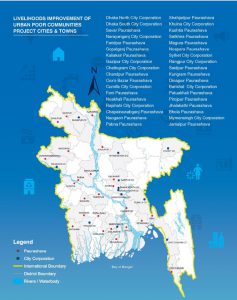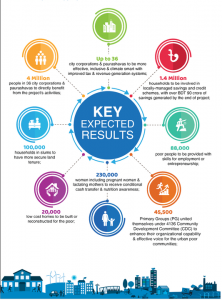About Us
BACKGROUND
Whilst notable advances have been made in strengthening urban governance and management over the last decade – much remains to be done. To ensure Bangladesh’s smooth transition from ‘low-income’ to ‘middle-income’ status, the large number of urban poor cannot be overlooked. Against this backdrop, the Local Government Division (LGD), Ministry of Local Government, Rural Development & Cooperatives (MoLGRD&C)- with financial and technical support of United Nations Development Programme (UNDP), Government of Bangladesh and the Foreign, Commonwealth & Development Office (formerly Department for International Development or DFID) - launched a national project to reduce urban poverty called ‘Livelihoods Improvement of Urban Poor Communities Project’ (LIUPCP).
The LIUPC project under UNDP’s National Urban Poverty Reduction Programme (NUPRP) follows the successful Urban Partnerships for Poverty Reduction (UPPR) project that demonstrated solutions to the urban governance challenges in Bangladesh. LIUPCP directly builds upon the experience of the DFID-funded and UNDP-implemented UPPR programme that developed a community-led approach to slum improvement in 23 City Corporations and Class A Paurashva in between 2008-2015, addressing issues of community empowerment, skills, livelihoods and small-scale infrastructure. LIUPCP will evolve this approach to tackle the structural drivers of urban poverty at the national, municipal and community levels. The project was officially approved by the Government of Bangladesh in August 2018.
PROJECT GOAL & SDGs
The project aims to contribute to balanced, sustainable growth by reducing urban poverty in Bangladesh and contribute to the achievement of the Sustainable Development Goals by 2030 that call for ‘leaving no one behind’. LIUPCP seeks to address urban poverty issues not through the direct implementation of infrastructure improvements, or charitable giving to selected urban poor beneficiaries; rather to influence the environment in which poverty reduction policies and thinking take place, and thereby having a potentially much more widespread and lasting effect by inclusion of poor in decision making processes.
In purview of Government’s commitment portrayed and articulated in the national strategies and long-term plans, the project through its five major intervention areas aims to contribute to SDG Goals, particularly SDG-1, (No Poverty), SDG-6, (Water and Sanitation), SDG 10 (Reduced inequalities), SDG-11 (Sustainable Cities & Communities) and SDG-13 (Climate Action). It will contribute to at least 9 SDG goals and contribute to achieving more than fifty associated targets through improvement in the livelihoods and living conditions of urban poor people.
BENEFICIARIES & BUDGET
The LIUPC project is designed to reach first the unserved and underserved urban population in Bangladesh. It aims to promote livelihoods and living conditions of up to 4 million poor people living in urban areas in up to 36 City Corporations and Pourashavas (12 City Corporations and 24 Class A Paurashava). In project interventions, women and people with disabilities will get priority. Initiated in July 2018, it will continue until June 2023 to make the lives of millions of urban poor better, by strengthening their communities and providing them with better opportunities.

KEY EXPECTED RESULTS

- Up to 36 cities and paurashava to be more effective, inclusive and climate smart with improved tax and revenue generation systems;
- 4 million people in 36 city corporations & paurashava to directly benefit from the project’s activities;
- 1.4 million households to be involved in locally-managed savings and credit schemes, with over BDT 90 crore (£83 million) of savings generated by the end of project;
- 88,000 poor people to be provided with skills for employment or entrepreneurship;
- 100,000 households in slums to have more secure land tenure;
- 20,000 low cost homes to be built or reconstructed for the poor;
- 230,000 women including pregnant women & lactating mothers to receive conditional cash and nutrition awareness;
- 45,500 Primary Groups (PG) united themselves under 4136 Community Development Committee (CDC) to enhance their organisational capability and effective voice for the urban poor communities.
INTERVENTION AT THREE LEVELS
LIUPCP’s approach will work simultaneously at three different levels: the community level, the city-level, and the national government level; at each level are distinct, yet complementary, interventions that support our overall goals:
The Community-level
Given the goal of empowering urban poor communities to be organized, pro-active, and participating in local planning and decision-making, LIUPCP’s work at the community-level lays the foundation for much of the overall approach. LIUPCP will help communities to organize themselves into PGs and CDCs, better understand the local context, and the relationships between urban poor settlements and the rest of the city, and to develop their own local development and resilience plans (CAPs). The organization and mobilization of women and women’s organization will be particularly important, as they are LIUPCP’s priority partners at the community-level. The voices and needs of the community will be shared through advocating for these CAPs, and also in dialogues and meetings at the ward-level (as part of the Ward-Level Coordination Committees (WLCC)). At the community-level LIUPCP will work towards the reduction of violence against women and girls, the reduction of drop-out rates for girls, improving nutrition for children, and the distribution of educational and skills building grants, as well as infrastructure and housing grants to support women, and extremely poor households.
The City-level
Since LIUPCP aims to improve municipal governance and public administration, and institutionalize more inclusive planning and decision-making, there is a significant emphasis on working on urban poverty issues at the city-level. For this a higher level of community organization will take place, mobilizing and organizing CDCs into town federations that are able to understand the issues that drive urban poverty, and advocate for more inclusive planning, across entire cities. Citywide assessments will also serve to provide a bigger picture of the vulnerabilities that urban poor communities, and the capacities and potential of municipal governments – to support the design of capacity building activities, improve revenue generation, and undertake strategic resilience and economic development planning efforts. A whole range of citywide data and maps will provide evidence to spur debate and inform discussion about urban policies and plans that can be discussed through the Town-Level Coordination Committees (TLCCs) and implemented by Mayors.
The National-Level
To bring about lasting, and widespread, change in urban governance and pro-poor policies it is essential that relevant ministries and agencies at the national-level are aware of, and can learn from, LIUPCP’s approach and impact in program cities. LIUPCP will share city assessments, analysis, maps, and lessons, to help build a more accurate picture of urbanization at the national-level. Through capacity building, sharing sessions, discussion workshops, together with scholars, think tanks, policy experts, and government officials, LIUPCP will be constantly advocating for the adoption of targeted pro-poor policies, plans, and raised budget allocations, with national-government institutions. A State of Bangladeshi Cities Report will help to synthesize this information and support the national government’s understanding and policy response to urbanization.
CROSS-CUTTING ISSUES
While the above five pillars represent the main orienting work areas there are three cross-cutting issues that work across LIUPCP’s activities, these are all integrated into each of the five pillars. These cross-cutting issues are: gender, ensuring that program activities prioritize reducing the vulnerability of women and girls; climate resilience, supporting efforts to boost climate adaptation for urban poor communities, housing, and infrastructures; and emphasizing the inclusion of disabled persons into cities. The activities related to each of the cross-cutting issues are listed here:
i. Gender
LIUPCP places gender issues at the core of activities throughout all three phases of implementation. Women’s perspectives will be better understood through gender audits, a gender-sensitive vulnerability assessment, and through a participatory mapping process involving women’s groups and other local residents, drawing on their experiences and local knowledge of conditions and issues. During the planning phase emphasis will be given to integrating the views of women and girls into community and city plans, making sure that women are well represented in public engagements, workshops, and forums, and that their voices are heard. Grants, training, legal support, and awareness raising outreach will all provide gender-focused support to women and girls, improving their access and safety, and helping men and boys better understand women’s perspectives, and alter their behaviour accordingly.
ii. Climate resilience
Reducing vulnerability and increasing climate resilience are critical issues at the core of each stage of the LIUPCP process. During the first phase a climate change vulnerability assessment will examine and document the physical, economic, and social vulnerabilities of urban poor communities, creating citywide hazard maps and helping to identify the vulnerable people, places, and systems (including economic sectors) in each city. During the planning phase this information will help to design and influence an inclusive planning and policy making process (for example the design of the Strategic Urban Resilience Plan); targeting investments in climate-resilient infrastructure where it is most needed, develop adaptive capacity, encourage institutional coordination, and implement resilience actions. During the Implementation Phase infrastructure and housing investments will implement these plans, providing climate resilient upgrades to reduce the impacts of climate hazards and shocks.
iii. Persons with disabilities
While persons with disabilities remain almost invisible in cities, especially those who are also poor, LIUPCP aims to raise the visibility of what challenges they face, and support them through advocacy, planning, and ensuring they benefit from LIUPCP projects, loans and grants. During the first phase a citywide assessment seeks to identify the issues that people with disabilities face. They will then be included in a participatory planning process, using the assessment information to help put forward ideas and proposals for better planning, design, and social protection measures that will benefit them. During the final phase persons will disabilities will benefit from grants and programs, such as employment and skills building.